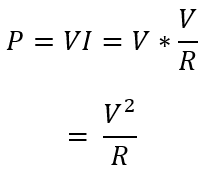
[From the last episode: We looked at the contribution that analog circuits make to powerThe rate of energy consumption. For electricity, it’s measured in watts (W)..]
We’re now going to look at some of the major things that affect how much power circuits can… draw? Use? It’s hard to find an accurate verb here, since, as we saw, circuits don’t “draw” or “use” or “consume” power; they do those things to energy. Power simply says how fast they do it.
But power isn’t the same thing as energy (something we’ll go into in more detail soon). They’re obviously related, but this time we’re specifically talking about power because we’re going to do some minor math.
Voltage Is Important
This time, our focus is on the effect that voltage has on power. You may recall that power is the product of voltage and currentThe amount of electrical flow. Measured in amperes or amps (A).:
![]()
But we also know, from Ohm’s Law, that voltage affects current I (where, you may recall, R is resistanceForces that tend to reduce the amount of flow or current. Measured in ohms (Ω).):
![]()
Or

If we use this expression for I in the power relationship, we find that:

In other words, power is related not to just the voltage, but the square of the voltage. If the voltage doubles, the power goes up four times. If the voltage triples, the power goes up nine times.
So if you’re looking for ways to reduce power, clearly voltage is one place to look. If you follow the history of logic circuits, for example, back in the 80s when I got out of college, everything pretty much ran at 5 V. Then that came down to 3.3 V. Now there are circuits running at voltagesVoltage is what gets electrons to flow. It's analogous to water pressure, which gets water to flow. Voltage is measured in units of "volts." like 1.2 V.
Why Use just One Voltage?
Based on this, one trick designers use is to turn circuits off when they’re not in use. That means dividing a big chipAn electronic device made on a piece of silicon. These days, it could also involve a mechanical chip, but, to the outside world, everything looks electronic. The chip is usually in some kind of package; that package might contain multiple chips. "Integrated circuit," and "IC" mean the same thing, but refer only to electronic chips, not mechanical chips. in to what they call power domains. In many cases, one can turn each one on or off. So, for example, communication circuits – the ones that talk to WiFiA common type of wireless network used to connect computers and phones to each other and the internet. or BlueTooth or whatever – are energy-hungry. So, with an IoTThe Internet of Things. A broad term covering many different applications where "things" are interconnected through the internet. device, which doesn’t have to “talk” much, you can keep those circuits off most of the time and turn them on only when there’s something to say.
But it doesn’t have to stop there. Many signals that run from chip to chip – inputs and outputs, or I/OsStands for input/output. This refers to the signals that come into and depart from the computing system (as opposed to the signals running internal to the computing system). – run at 5 V or 3.3 V or something higher than is really needed for the inner workings. So that means that different voltage domains can run on different voltages.
Whether the voltage domains turn off or are at different voltages, it’s important to protect signals at the boundaries, where they cross from one domain to another. All circuits are created with assumptions, and one of them will be that the supply voltage is the highest voltage around. Well, if you’re sending a signal to a domain where the power is off, then that assumption isn’t true, and unexpected things can happen if the designer isn’t careful.
Moving the Threshold
There’s been another effect of the importance of voltage. Let’s say we bring the supply voltage down to, oh, 0.7 V. Now… transistors have a threshold voltageThe voltage at which a transistor starts to turn on. It’s technically "off" below that voltage, although it is still ever so slightly on. that determines when they turn on. Historically, that threshold was in the range of 0.5 to 0.7 volts, plus or minus. If the supply voltage is 0.7 V, then that’s basically the same as the threshold. There’s no way to make a signal go higher than threshold unless you’re somehow making it go higher than the supply voltage (hint: possible if the signal is coming from a power domain with a higher voltage, but, other than that, unlikely).
So what we really want is to build a transistor with a lower threshold voltage. But that’s not so easy. The threshold voltage is set by physics. So, to change it, you need to change something fundamental – like the materials you use to build the transistor. There are lots of ways in which engineers have played with what’s called the work function of the materials to lower the threshold.
All in all, lots and lots of effort has gone into reducing voltages to help lower power. Including some special tricks we’ll look at next. After that, we’ll see that voltage isn’t the only thing affecting power.

Leave a Reply